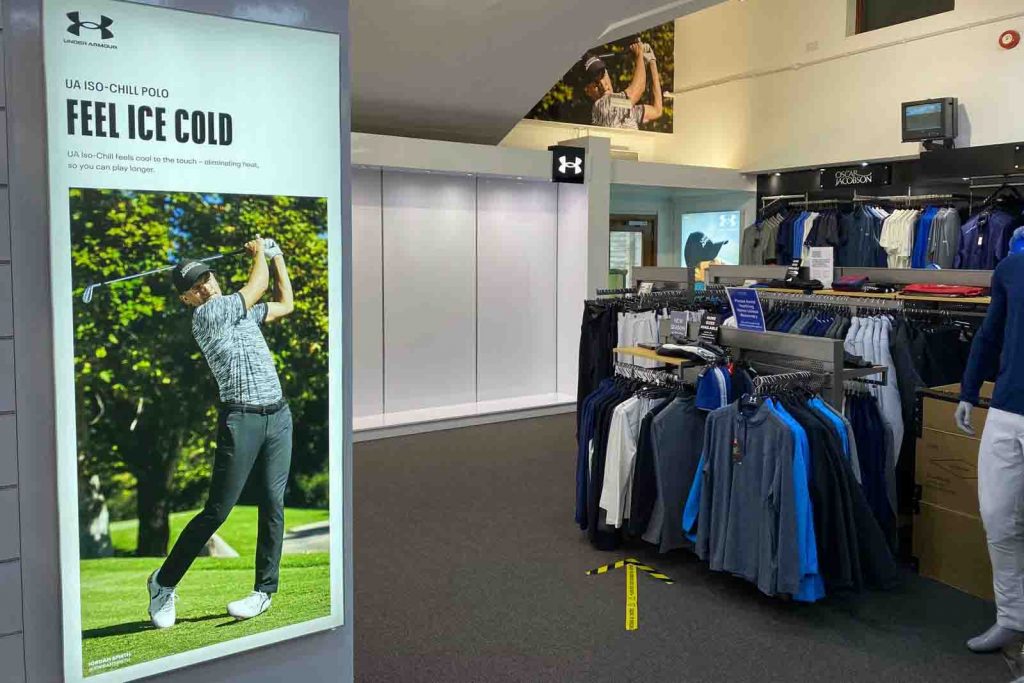Why Under Armour have partnered with the GCMA and their hopes for the Association
How did the partnership between GCMA and Under Armour come together?
It’s interesting as a year ago I really wouldn’t have known much, if anything, about the GCMA but across the last six months I’d begun to be aware that something was happening and it had flagged on my radar without me actively seeking to discover it. I’ve talked this through with Tom Brooke and Craig Cotterill over the last few weeks and it’s become clear that the work they had been doing in the background had led to this happening.
They had implemented a new vision for the GCMA and what they had been putting in place pricked my interest. It was resonating in terms of ‘there’s someone there who’s looking to make a change’. The decision to appoint a young, dynamic CEO in Tom spoke to this – it was a bold statement of intent by a body with such a long history.
This was a big attraction. I felt it reflected a body that wanted to move forwards with a desire to make a difference. I looked at that and it mirrored with where I believe golf is right now. We’ve had years of ‘Get Into Golf, grow golf, increase participation etc’ but we’ve not really seen any of them work to any degree. The industry has been guilty of ‘speaking to itself’ and this has resulted in a sport that had been declining year on year and seeing huge challenges in retaining participants as societal pressures shifted.
What I liked was how the GCMA is approaching what I believe to be a unique time for the sport. It’s an incredible opportunity because, while it is a terrible pandemic that we’re facing, what has come from it is the explosion in participation that all the previous initiatives had failed to deliver.
My sense was that I’d love to work with an organisation that was clearly looking at this opportunity with a fresh set of eyes and saying ‘we’ve got a unique chance here and we’ve got to get it right. And if we do what we’ve done, we’ll go back to what we had before. We’ve simply got to approach it differently and we have to act now’.
So that’s what really pulled me toward the GCMA. It looked and felt really progressive from the outside looking in.
Is it about seizing an opportunity then in terms of what the GCMA are trying to do and what Under Armour are trying to do as a brand?
We’ve talked a lot internally about the rationale behind our partnership and, really, the best word to describe it is holistic. It’s about doing what’s right for the sport.
It wasn’t about ‘how much can we gain commercially from this?’. We want the sport to be healthy. We believe we can play an active part in helping to achieve this but we need to do this collaboratively with the people that drive the game and effectively dictate the experience the golfer will have when they visit a facility. Collectively we need to be driving the sport forwards.
My belief is that nobody is better placed right now to shape the future of the sport than the GCMA.
When you pull into the car park, everything you experience from that moment onwards should fall under the remit of the golf club manager. If we can all actively input positively into the consumer experience then I believe that more people will stay in the sport. That’s good for the sport, it’s good for Under Armour, and it’s going to be good for every facility and brand in golf.
It is an incredibly unique time and what I saw was a body with a different mindset. People talk about the new normal. It isn’t. It’s completely different. Normal isn’t the word for it because it’s a completely new way of approaching the sport from an experience led perspective. People will vote with their feet and I think they were doing that pre-pandemic and that was leading to the exodus from the sport.
I love how Tom provides clarity on the different experience that facilities can offer but that they need to be very clear on their strategy. They need to know what they’re good at and focus on it. Some will be members’ only, high-end golf with a very specific dress code. Some will be more open access and family oriented.
The sport needs them all. But what you don’t need is everybody trying to be everything to everybody. I believe facilities being able to understand who they are, and the GCMA helping them define and refine their strategy to deliver it, will be really important to the end result. We all know that when we go somewhere and have a good experience we tend to go back and we tell people about it. When we go somewhere and have a bad experience, we don’t go back but we still tell people about it.
Allied to this mindset, I really like the fact the GCMA are redefining the career opportunity provided by golf club management. It’s no longer an end of career role – it’s a full-time career from an early age with the ability to shape the future of what golf can be through vision and execution.

Clearly the GCMA and Under Armour share the same ideas for the future of golf. How do you see the partnership working? Association staff will wear your brand, and presumably spread the message, but how do you see the relationship moving forward?
That’s been the hard bit to put our fingers on – between both of us – and we’ve been really open about that because, typically, when you buy into a commercial package there’s a list of commercial benefits you receive from advertising and so on.
We’re not here for that. We’re not here to try and drive sales of Under Armour. Whilst we’re very proud the GCMA are going to wear Under Armour and, hopefully, they’re proud of wearing Under Armour too, it was really about ‘how can we input? How can we be part of this movement?’.
We love the idea of the Future Leaders’ [Group]. They’re going to shape the game for many years to come. They can be the driving force, the people with great ideas and with both the commercial sense and the passion to deliver them.
The thought of being around the same table is exciting – to be hearing their vision for the sport, how they’re going to deliver it and what they are seeing and learning from that delivery. It just gives us a greater, more rounded knowledge of the sport and I think we’ve got as much to learn as we have to input.
We’ve been talking with Tom and Craig about where we can plug in and what can we bring and they are keen that we discuss our journey and our thoughts on how we’ve achieved what we have. We’ve become the dominant market leader in apparel with double the market share of the nearest competitor and there is a belief that some of our approach can impact positively within the GCMA.
As a company we often look outside the industry for inspiration and have worked extensively with the ex-Olympic swimmer Chris Cook. We are hoping that we can collaborate with Chris to illustrate to GCMA members the benefit of clinical rationalisation – and there is no better example than elite sport in terms of a culture that is solely focused on what truly makes a difference and removing anything that doesn’t.
We have that mindset and I believe Tom does. He has two golden rules. Is it relevant? Is it visible? We love that because we have golden rules too and if something doesn’t meet them we just don’t do it. It simplifies things, but simple isn’t always easy. So we’re very aligned on that part.

And if there’s a company that can talk about increasing participation, for example, then that’s your experience. You entered a marketplace that was extremely competitive and have managed to really push forward. With the likes of Jordan Spieth and Matt Fitzpatrick as ambassadors, you’re very much a part of the golfing landscape…
It’s nice to hear that – thank you. Whilst we are now an established golf apparel company, one of our biggest focuses right now is driving our golf shoe business. We were new to golf shoes in 2016 and it takes a bit of time to get going in a very congested market.
It’s got a market leader and some very established brands within it. We moved to number three in the market last year and became the number one athletic brand. To become number three in that space of time, with our sights on number two this year, you have to stand for something different. You have to get your strategy and your vision across to the consumer in a compelling manner. You’ve got to earn their trust – but if you get it wrong, they won’t come back. We had a few false starts, but we righted the ship and we are on a great trajectory now.
There are good examples within that part of our story that members can take directly and say, ‘this is my facility, this is what I’m offering, this is what I can do. This is how I can bring more people to my facility and this is how I can retain them longer’. It’s a process we can all share and help improve upon.
We’ve already talked a lot about retention with Tom and Craig. It’s not about stealing money from people’s pockets. It’s about giving them a choice of where and how they spend their money. The better the experience, the more likely they may invest and that creates a healthy facility. Rather than finish the round, jump in the car and go somewhere else, it becomes the place where you’re happy to be around longer and invest your time and money.
I’m really excited about helping to empower GCMA members to shape the game, because they will be the people that can show respect to the game but also see where they can truly take it next. We want the industry to look at this group as being the pioneers of the new golden age of golf.
I believe that they should be respectful but not reverential. They can drive change but also ensure that the avid golfer still gets the experience they want from a golf course – that they don’t go home and say ‘this isn’t me anymore. What has my favourite place become?’.
The GCMA are going to have to navigate a few different obstacles but, from my time around them so far, I’m really confident that they will be successful.
Just think about what they have achieved – the likes of the Online Learning Portal – in less than a year. It is phenomenal and if you look at the team: it’s small but it’s empowered and passionate. It’s set to make a big impact on this sport.
As you say there is GCMA Perks at Work, the Community Online Academy, the wellness platforms that are being launched as well as a number of other membership initiatives…
Isn’t it great to think that’s happened in such a short period of time? That means you’re not just saying it, you’re doing it and you are delivering at pace.
My worry was whether we are doing enough as a sport to make the most of this opportunity. If there were four or five organisations doing incredible things, I’d be torn. ‘Where do I go? Do you even need me? There’s so much good going on that this is all going to take care of itself’. But the GCMA stood out head and shoulders above the rest – that’s why I’m delighted for Under Armour to become a Strategic Partner.

Under Armour
Under Armour were founded in 1996 by former University of Maryland footballer Kevin Plank. The company’s genesis was to make a ‘superior T-shirt’ that provided compression and wicked perspiration off the skin. The aim was to regulate temperature and improve performance. Under Armour took off quickly and became a mainstay in the NFL before branching out into a host of other sports and athletic wear. In golf, Under Armour ambassadors include Jordan Spieth, Matthew Fitzpatrick and Emily Pedersen.
Richard Palmer-Jones
Richard Palmer-Jones is the owner of PJH Brand Management, who are the official partner of Under Armour Golf in the UK and Europe.
A University of Leicester and Leeds Business School graduate, Richard has extensive experience in the golf industry, having previously been marketing manager at Ashworth Golf for four years before spending a further four years as brand director at TaylorMade adidas Golf. His company launched Under Armour golf in the UK in 2006 and now runs all golf distribution for Under Armour across the UK and Continental Europe.
Do you subscribe to the GCMA’s weekly E-newsletter? Make sure you’re not missing out on the latest in the world of golf club management. Click here to join in.



